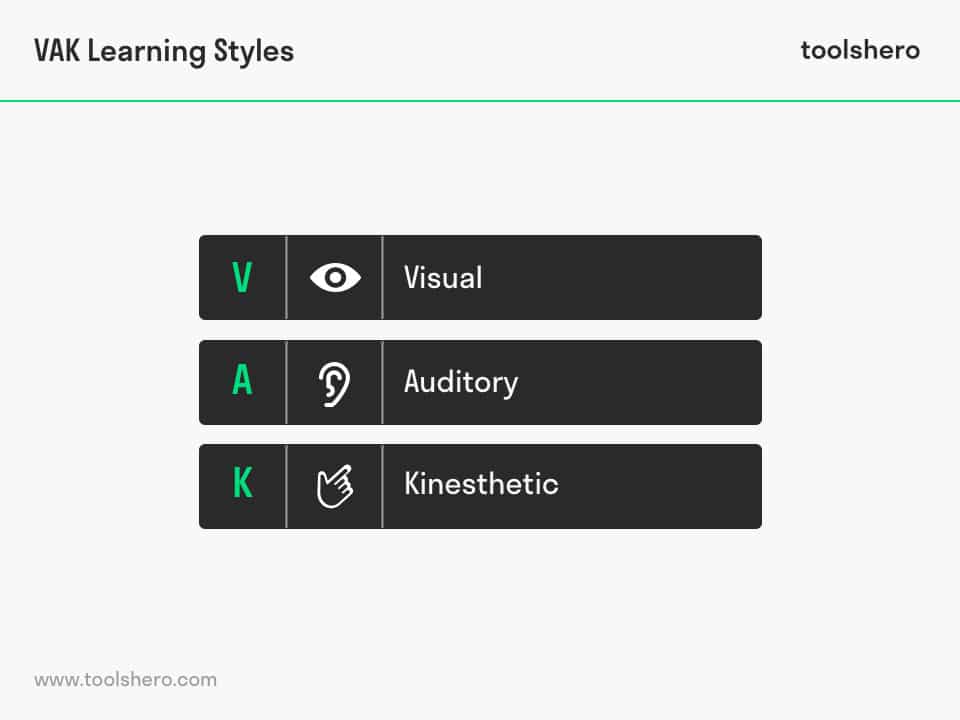VAK Learning Styles

VAK Learning Styles: this article describes the VAK Learning Styles in a practical way. It covers what the VAK Learning Styles are, provides practical examples and offers tips for integrating each learning style into a learning environment. After reading you will understand the definition and basics of this powerful communication and learning styles tool.
What are VAK Learning Styles?
The VAK Learning Styles Model was developed by psychologists in the 1920s. It indicates the most common ways in which people learn and consists of three classifications, namely the Visual, Auditory, and Kinesthetic learning styles. Everything we perceive with our eyes is visual, that which we can hear is auditory, and all our physical interactions belong to the kinesthetic.
These three main sensory recipients can bring about a dominant learning style. The method is also known as VAKT, in which Tactile is added to the acronym VAK.
In most cases, Tactile (that which people can tangibly feel) is merged with the Kinesthetic learning style. By knowing how people learn, it becomes easier to understand the differences between team members. Moreover, it allows you to integrate all three learning styles into an effective training course.

Figure 1 – The Three Learning Styles. Do you want to learn more about learning styles and personal development? Become a member.
Human Interpretation
The VAK Learning Styles consists of a combination of perception and memory. Human interpretation takes place through different channels, with the modalities of vision, hearing, and feeling occupying an important position.
By presenting subject matter or other information using all three learning styles, this allows listeners, students, or pupils to become more engaged with the information provided. They will then absorb the right information based on their preferred style.
In addition, in practice it appears that human interpretation is optimally achieved through a mix of these three styles.
Dominant Preference
People have a dominant learning preference, which is already present from an early stage. For example, one person may be able to concentrate by talking about a certain topic or listening well (auditory), whereas others may excel more when taking direct action (kinesthetic) or by looking at pictures and creating sketches and drawings (visual).
According to the VAK Learning Styles, one or two of these learning styles are dominant and help people properly absorb new information. However, this preferred style doesn’t have to be the same in every situation.
Nonetheless, people use all three modalities to receive, process, and learn new information and experiences. This style of learning has been incorporated in classical education and is linked to age. For example, in kindergarten and the early years of elementary school, a lot of attention is paid to the kinesthetic transfer of learning material.
Children learn maths tables by dancing and clapping their hands, making them remember them better. In later years of primary education, there is also a lot of emphasis on the visual presentation. Moreover, from secondary school right up to college/university and one’s working life, there is a lot of focus on auditory transfer through lectures.
VAK Learning Styles characteristics
By recognising someone’s preferred style, it can be implemented in an individual student’s teaching programme, increasing their learning ability. For this reason, it is important to know the characteristics of the various modalities, or types of learners:
Visual
Visual learners learn better if the information is presented through images, mind maps, graphs, or diagrams. In addition, there are also two sub-classes of the visual: the linguistic and spatial.
In the visual-linguistic learning style, people have a strong preference to learn through written language. They like to read and take notes and write extracts. In this way, they often remember the lesson material immediately.
In the visual-spatial learning style, people prefer to receive information through demonstrations, videos, graphs, or other visual material. Compared to people with a visual-linguistic learning style, they have difficulty absorbing information through written language. They think in images and often visualise certain situations.
The following tips may be useful for integrating this learning style into a learning environment:
- Use graphs, illustrations, or other visual aids.
- In PowerPoint, include clear keywords that support the story.
- In PowerPoint, use images that support the story.
- Create handouts and share them beforehand, so that participants can take notes.
- Use a flip chart that people can write on.
- Invite participants to write down questions.
Auditory
People with an auditory learning style within the VAK Learning Styles tend to talk to themselves or move their lips when reading, according to the VAK Learning Styles. Auditory learners often find reading and writing tasks difficult and will have trouble concentrating on those.
They prefer talking to others and discussing the material. During presentations, people with an auditory learning style will mainly focus on what’s being said.
The following tips may be useful for integrating this learning style into a learning environment:
- When introducing new information, provide a short explanation and conclude with a summary.
- Ask the audience questions and apply interactive methods.
- Make frequent use of brainstorming sessions and record discussions with a voice recorder.
- Create dialogue between listeners and students and have them enter into discussions and listen to each other’s points of view.
Kinesthetic
Someone with a kinesthetic learning style will prefer to interact with learning material through direct contact or motion. For kinestetic learners, the physical experience is most important.
They prefer a more practical approach. Like the visual learning style, the kinesthetic style also has two sub-classes: one has more affinity for learning through motion, the other prefers learning through direct contact.
People with a kinesthetic learning style lose their concentration when there is little or no external stimulation or movement. They often use high-light pens to keep busy and emphasise specific passages in texts. They also like to doodle or sketch while listening. By remaining active, they are better able to understand the learning material.
The following tips may be useful for integrating this learning style into a learning environment:
- Use game activities to keep people active.
- Use background music.
- In PowerPoint presentations or on flip charts, use coloured markers to emphasise important points.
- Regularly take breaks and have students ‘stretch their legs’.
- Offer listeners or students kneaded balls to squeeze while listening.
- Ensure interaction with listeners/students, allowing them to actively participate.
VAK Learning Styles and imagery
The way in which people talk also characterises the learning style and preferred style within the VAK Learning Styles. For example, visual students will focus on everything they perceive with their eyes.
They’ll have the tendency to look up a lot and may reply with sentences such as ‘I see what you mean’, ‘I see a clear picture’, and ‘what’s your view on this?’.
Auditory students are focused on everything they perceive through hearing. When talking to others, they’ll often look left or right in the direction of the other person’s ears. Frequent statements of auditory students include: ‘that certainly rings a bell’, ‘I hear what you’re saying’, and ‘sounds good’.
Kinesthetic students are sensitive to everything perceptible through touch. When talking to others, they frequently use their hands and will find it difficult to stand or sit still. They’ll often use sentences such as ‘that feels good’, ‘I can try it’ or ‘how should we do this?’.
Now It’s Your Turn
What do you think? What are your experiences with the VAK Learning Styles? Do you recognize the practical explanation or do you have more additions? Can you recognize someone’s prefered learning style and what is or was your preferred learning style?.
Share your experience and knowledge in the comments box below.
More information
- Bishka, A. (2010). Learning styles fray: Brilliant or batty?. Performance Improvement, 49(10), 9-13.
- Schreurs, J., & Moreau, R. (2006). Learning objects (LO) aligning different learning styles.
- Surjono, H. D. (2011). The design of adaptive e-learning system based on student’s learning styles. International Journal of Computer Science and Information Technologies, 5(2), 2350-2353.
How to cite this article:
Mulder, P. (2019). VAK Learning Styles. Retrieved [insert date] from Toolshero: https://www.toolshero.com/communication-methods/vak-learning-styles/
Published on: 03/04/2019 | Last update: 08/20/2023
Add a link to this page on your website:
<a href=”https://www.toolshero.com/communication-methods/vak-learning-styles/”>Toolshero: VAK Learning Styles</a>












